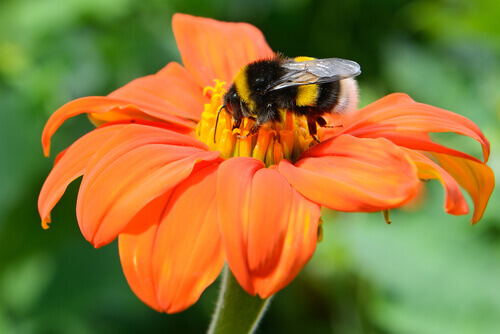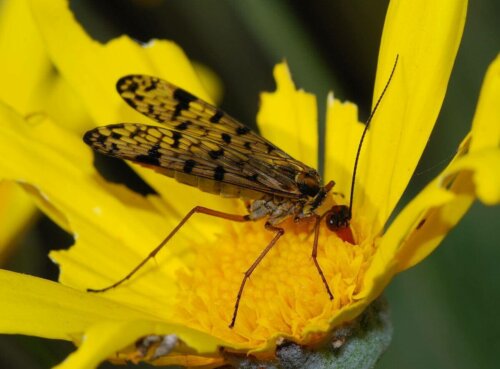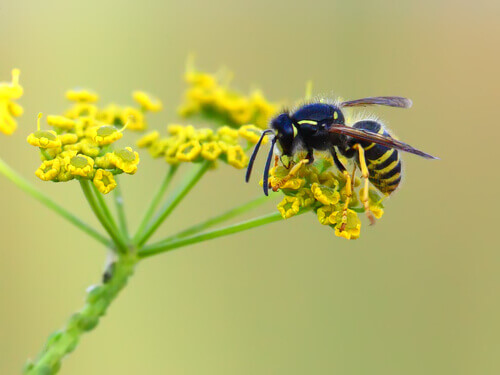Animal-Plant Pollination is an Ancestral Symbiosis

The end of spring approaches, and with it, the annoying allergy symptoms that afflict many of us throughout this season. This bothersome reaction of the immune system happens due to the entry of pollen into the respiratory tract. Pollen is rather unpleasant to us and yet is crucial to many species who perpetuate ecosystems through the ancestral symbiosis of pollination.
Indeed, the pollination process is essential for the functioning of the world as we know it. This is because plants are the basis of the food chain and the production of terrestrial oxygen. Thus, life wouldn’t be possible without it. Continue reading to find out how this ancestral symbiosis between pollinators and plants took place.
What’s pollination?
Firstly, let’s define the term:
Pollination is the transfer of pollen to a stigma, ovule, flower, or plant to allow fertilization.
There are several types of methods to do so:
- Anemophilic plants use the wind to disperse pollen through the environment
- Hydrophiles are aquatic plants that use water as the main dispersal method
- Finally, there are zoophilic plants and these use an animal vector as a pollen transmitter. This is the type of plant we’ll focus on below.

Pollination is an ancestral symbiosis
The relationship between plants and pollinators is a clear example of coevolution. This is because both components have evolutionarily adapted to maximize the benefits of the interaction. OK but, how did symbiosis happen?
Here’s an explanation of several studies collected in this article:
- Fossil records revealed that plants were mostly anemophilous during their early evolutionary stages on the planet
- During the Triassic era, certain groups of insects moved from a hematophagous diet (blood eaters) to a phytophagous diet (feeding on the living parts of plants); this was mainly because these were more available and thus easier to access
- This change was a severe blow to the plants as the pressure exerted by herbivores on them made their survival and reproduction extremely difficult
- In response to this pressure, plants began to produce allelopathic compounds derived from secondary substances in order to repel or poison their predators
- Despite their effectiveness, these compounds were energetically expensive for plants, reducing their chances of survival and reproduction
It seemed plants were at a dead end… Would it be best to protect themselves by expending energy that would decrease their chances of survival? Or should they stop defending themselves in the hope there would be no attacks? In the end, natural selection had an answer — as usual.
If you can’t beat them, join them
Plants took the most consistent evolutionary path over the centuries. They figured out a way to join and benefit from their enemies.
This is when nectar production, which has a triple function, began:
- Due to its sugary nature and the fact that it arises from striking structures such as flowers, it completely diverts the attention of small living beings towards the floral structures, leaving the leaves and the stem alone. You may not be aware of it but these are more important for a plant to survive.
- Nectar offers a healthier food source alternative food to insects as it’s more nourishing than the leaves in lower doses.
- Finally, it also helps the plant reproduce, even if it requires a higher expenditure of energy. This is because they take advantage of an insect’s visit by having them carry the pollen to other plants. The way they do so is by surrounding the nectar with pollen.

An ancestral symbiosis that’s all about cooperation
This evolutionary mechanism is exciting. It shows that nature can establish symbiotic relationships instead of predation in some instances.
In a simplified way, the plant makes a better offer to the pollinating insects: “I’ll trade you my leaves for something yummier.”
Thus, both animals and plants have co-evolved over time maximizing the benefits of this interaction.
All cited sources were thoroughly reviewed by our team to ensure their quality, reliability, currency, and validity. The bibliography of this article was considered reliable and of academic or scientific accuracy.
- Animales polinizadores: con el polen a cuestas, National gographic. Recogido a 2 de junio en https://www.nationalgeographic.com.es/naturaleza/grandes-reportajes/animales-polinizadores_4423/5.
